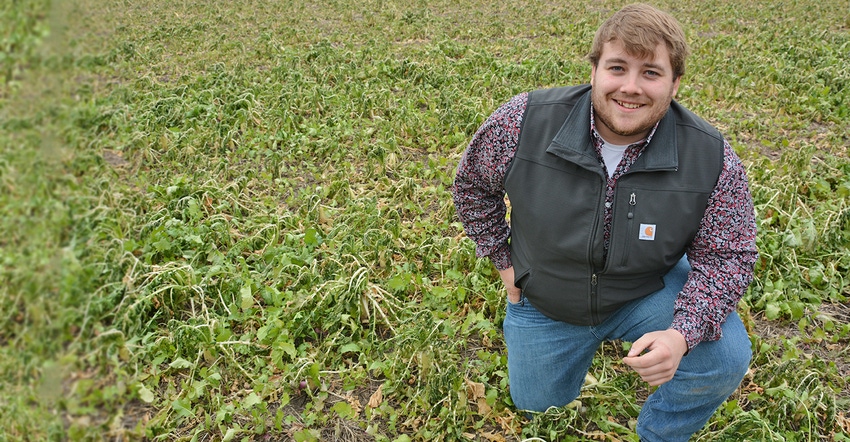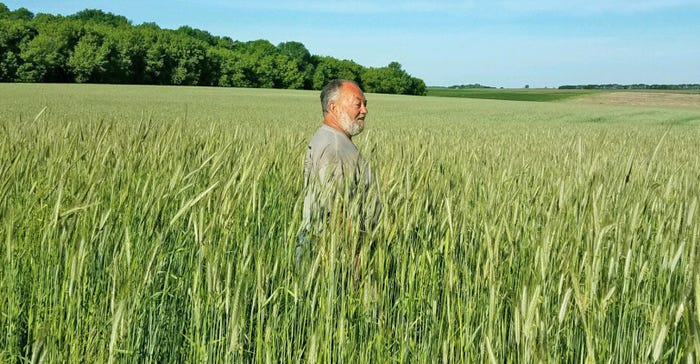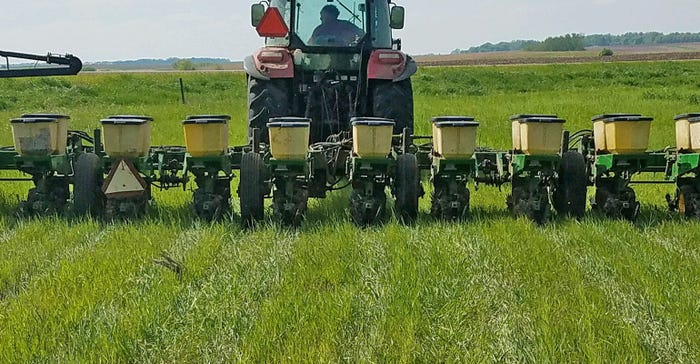January 31, 2018

If you go to a no-till/cover crop meeting in South Dakota, you might meet Brad Schmidt and hear him say: “This no-till and soil health stuff works. We did in our farm and it has really made a difference.”
Schmidt is a Ducks Unlimited agronomist who works out of Brookings, S.D. A 2017 South Dakota State University graduate, Schmidt worked for two years while in school at the Dakota Lakes Research Farm under Dwayne Beck, an SDSU professor and no-till pioneer on the Northern Plains.
Brad’s father, Chris, and grandfather, Dale, farm near Garvin, Minn., in the southwest part of the state. The farm has been in their family for 101 years. At one time, the farm was pretty substantial, covering about 1,200 acres. Through the drought of the 1930s and farm crisis of the 1980s, it shrunk in size to just 130 acres, 20-30 stock cows and 300 ewes today. The Schmidts finish the calves and lambs themselves. Chris and Dale were carpenters full time and farmed part time.
About five years ago, Brad — who was in college at the time — talked his father and grandfather into trying no-till.
“I had been thinking about it,” Chris says.
They had always been interested in conservation, liked having wildlife around, and left food plots and habitat for them on their land.
They had been following the global warming debate, too, and wondered what they could do minimize their farm’s carbon footprint and protect soil, water and air.
 BACK TO WHEAT: Wheat is shoulder high on Dale Schmidt
BACK TO WHEAT: Wheat is shoulder high on Dale Schmidt

Brad’s grandfather wasn’t convinced no-till would work, though, and kept most of his land in conventional tillage when Brad convinced his father to change. That turned out to be good, because it gave the Schmidts an on-farm test of the two tillage systems.
Convention-till and no-till yields were about the same the first year, but “we were able save $35 per acre on fuel, repairs and labor the first year by cutting out tillage,” Brad says. “Grandpa saw the difference and converted his to no-till the next year.”
The Schmidts soon began diversifying their crop rotations. They adopted a stacked corn-corn-soybean-small grains-soybean rotation modeled after what Beck was doing at Dakota Lakes. The stacked rotation reduced their costs even further. They were able to use a rye cover crop the first year with corn that helped provide residue to control weeds. The rotation interrupted pest and weed cycles. They have been able to plant conventional corn hybrids and haven’t had to use an insecticide.
They started planting cover crops — mainly cereal rye, but also turnips, radishes, clover, flax, mung beans, oats, peas, lentils, millet, sorghum, buckwheat and other species — to produce more residue to cover the soil and to feed the soil organisms.
They started grazing cattle on the cover crops and cornstalks, which reduced their winter feed costs and spread manure on the land.
The Schmidts measure the positive impact of the new system in the amount of fertilizer they have to buy and their yields. They used to apply about 160-170 pounds of nitrogen per acre. Their corn averaged about 170 bushels per acre. Now they apply about 100 pounds of N per acre, and have a 200-bushel per acre yield average. Their soybean yields have risen from 35-40 bushels per acre to 60-70 bushels per acre. They don’t apply any phosphorus or potassium. They use the Haney soil test to estimate how much carbon the soil organisms will mineralize each year.
“We are not king of the county for corn (yields),” Chris says, “But out our profit margin is wider than it has ever been.”
 PLANTING BEAN: The Schmidts plant soybeans into rye cover crops.
PLANTING BEAN: The Schmidts plant soybeans into rye cover crops.

Since they have adopted a soil health focus, the Schmidts have been able rent more land. Three years ago, they picked up about 470 acres of land from the Minnesota Department of Natural Resources. The DNR and the USDA Natural Resources Conservation Service are doing a five-year study on impact no-till and cover crops have on soil organic matter, water infiltration rates, nutrient cycling and other factors. The organization Pheasants Forever has talked to them, too, about farming some of their land until it is converted back to grass. The Schimdts now farm 600 acres and are aiming to finish cattle and lambs on grass and direct market them to consumers.
More landowners may be looking for farmers who no-till and use cover crops to lease their land, Chris says. They’ll be interested in soil health and good things the system does for the environment.
“I think there will be a movement,” he says.
Brad is pleased that his family is taking advantage of the opportunity.
“We are growing again,” he says.
For more information, contact Brad at 605-592-1277 or [email protected].
You May Also Like




